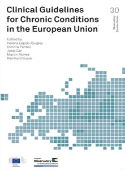Clinical guidelines for chronic conditions in the European Union (2013)

Download
Edited by Helena Legido-Quigley, Dimitra Panteli, Josip Car, Martin McKee and Reinhard Busse
2013, xxviii + 229 pages
ISBN 978 92 890 0021 5
CHF 60.00
In developing countries: CHF 42.00
Order no. 13400135
Chronic noncommunicable diseases make up a large part of the burden of disease and make a huge call on health systems’ resources. Clinical guidelines are one of the ways European countries have tried to respond and to ensure a long-term perspective in managing them and addressing their determinants. This book explores those guidelines and whether they actually affect processes of care and patients’ health outcomes. It analyses:
- the regulatory basis, the actors involved and processes used in developing clinical guidelines across Europe;
- innovative methods for cost-effective prevention of common risk factors, developing coordinated patient-centred care and stimulating integrated research;
- the strategies used to disseminate and implement clinical guidelines in various contexts; and
- the effectiveness of their utilization.
This study reviews for the first time the various national practices relating to clinical guidelines in 29 European countries (the European Union (EU), Norway and Switzerland). It shows that, while some have made impressive progress, many are still relying on sporadic and unclear processes. The level of sophistication, quality and transparency of guideline development varies substantially across the region, even when the system for producing guidelines is well established. There are nevertheless clear examples that – if shared – can assure and improve quality of care across Europe.
This study was commissioned by the European Commission’s Directorate-General for Health and Consumers. It also benefited from links with the ECAB/EUCBCC FP7- research project on EU Cross Border Care Collaboration (2010–2013).



